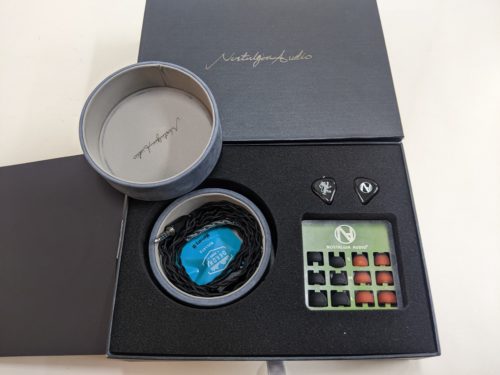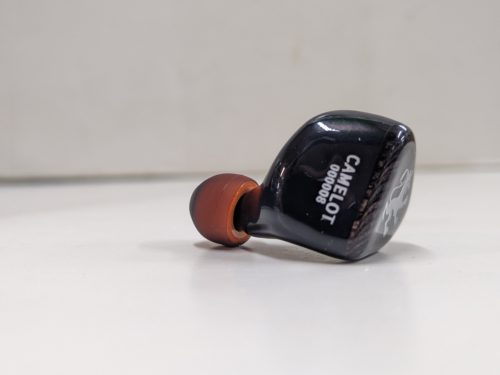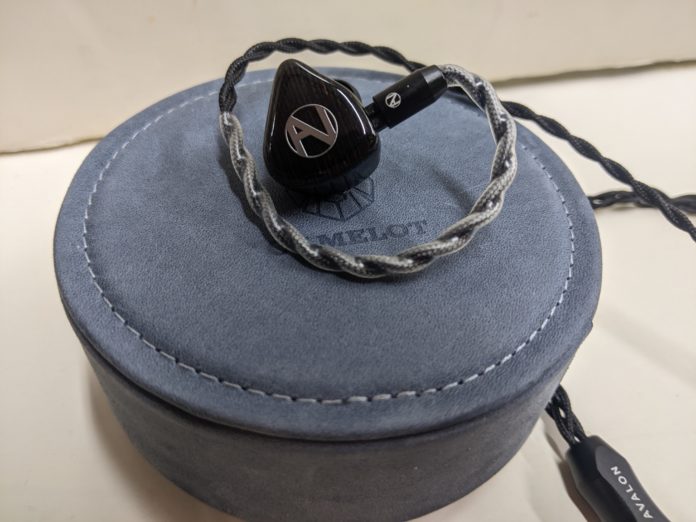Nostalgia Audio Camelot Review
It’s always a serendipitous occasion when a mysterious new audio company delivers an earphone that nonchalantly becomes a new favorite.
Founded in 2020 and featuring only four models of universal in-ear monitors on their site, it’s fair to say that Nostalgia Audio is pretty new to the IEM game. So, perhaps you can forgive me when I say that this is the first unit I’ve tried from the company – in fact, it’s a MajorHifi first. After spending a day with their new flagship IEM, the Camelot, I have to say, I’m pretty floored. Let’s talk about some of the unique practical and technical features this elite $2,599 IEM is packed with before we get into what it sounds like.

What’s In The Box?
-Nostalgia Audio Camelot IEMs
-2 pin to 4.4mm “Avalon” High Purity OFC and OCC Copper Cable
-3 Pairs of Silicone Ear Tips
-3 Pairs of Symbio with Silicone & Foam Hybrid Ear Tips
– 1 Pair Foam “Bulletz” Ear Tips.
-Firm Carrying Case
Look and Feel
The housing isn’t particularly flashy, but has a subtle classiness. Sitting behind the silver logo and emblem on the backs of the buds is a dark, wooden texture with a thick, transparent finish. The high purity OFC and OCC copper cable is pretty plain and black, but more importantly, has a durable quad-braid design and nylon insulation. The Camelot is packed with drivers (more on that later), and is a bit chunky as a result. That said, the softly rounded design let the edge of the housing rest against the rear inner ridge of my outer ear with a casual comfort.
The real star of the fit, however, is found in the ear tips. A lot of premium IEMs include nine or even twelve pairs of tips to provide all the standard material options in as many sizes as possible. Nostalgia Audio instead opts to include just two types of tips: standard silicone and some truly unique silicone-foam hybrid tips (ok, fine, and one regular foam pair). The difference between these two ear tip materials is a perfect balance of subtle and noticeable. The standard silicone tips allowed the Camelot to go further into my ear canal and have the housing hug my ear to provide isolation. The Symbio tips left the Camelot sticking just a little further out from my ears, but provided firm isolation within my ear canal. There are some interesting things to be said for how these tips affected the balance as well, but I’ll get into that in just a moment.
Design and Technical Specifications
Two dynamic, four balanced armature, and four electrostatic drivers are packed into both the left and right sides of the Camelot. An impressive 5-way cross-over system provides a refined division of labor for these drivers: one dynamic driver for subs and one for bass, two balanced armatures for mids and another two for highs, and an exciting four electrostatic drivers just for “ultra-highs.” Nostalgia Audio 3D prints both the shell and acoustic chamber that houses these drivers to ensure a consistent build and sound across every Camelot unit. The company’s proprietary hidden airflow design hides and protects the vents used to regulate the air pressure of the dynamic drivers, which feature N52 neodymium magnets for an enhanced bass response.
–Drivers: 2 Dynamics, 4 Balanced Armature, 4 Electrostatic
–Impedance: 13 Ohms
–Frequency Response: 15 Hz – 40 kHz
–Sensitivity: 114 dB/mW

Sound Stage and Imaging
While I loved the Camelot’s balance, it was its ultra-wide and accurate imaging that thrilled me the most. The rapid, winding pans in St. Vincent’s “Digital Witness” and “Rattle Snake” sent the stage spinning around my head with not just a width, but a depth that is truly rare to find in closed-back IEMs. Vocals and kick drums sat squarely behind my forehead and jaw in sharp mono contrast to this exceptionally large and playful sonic shape. Asymmetries in mixes were left totally exposed, and gave tracks that were panned separately from their respective reverb a spatial quality that left me with a jarring physical sensation. A unique quality to the staging that I experienced was what I would term the “box seats;” the main stage was highly fluid and connected, but when pans got really dramatic, they seemingly decoupled from the rest of the stage and sat in a more isolated distinction from the rest of the image. Though some people might read this and think that I’m calling the sound stage notchy, this couldn’t be further from the case. Rather, it was like having a stereo mix play in a semi circle of numerous speakers, with the furthest-reaching pans finding a striking isolation when sent to the singular, furthest-most speaker on either side. I understand this may be a complicated way of describing an IEM’s stage, but the Camelot’s imaging is so fascinating and peculiar that more typical descriptions just can’t do it justice.
This level of spatial clarity worked in synergy with the Camelot’s utterly consistent balance. I always try to find even the smallest band of thinness or weakness in a headphone or IEM, but I came up empty handed this time. This isn’t say the Camelot doesn’t have its own unique boosts and coloration – I’ll be getting into that below.
Lows
The bulk of the Camelot’s low end boost is found in its punchy mid bass and complimented with crisp transients in the highs, but powerful, physically-felt subs are activated when called upon. These disciplined subs provided a level of clarity that a lot of bass heavy units sacrifice by including whopping lows that are a little too eager to come charging into a balance. The two dynamic drivers with alternate crossover points seem to be serving their intended purpose to provide this low end clarity, as subs had a way of appearing with a distinct, smooth texture that sat on a separate layer from the growly mid bass.
Going back to the ear tips, the Symbio hybrids seemed conducive to a more balanced sound with their firm quality stifling some sub-bass vibrations. The standard silicone tips let more rumble into my ear canal and led to a more bass-heavy overall balance.
Mids
The Camelot’s exceptionally even-handed approach to its center frequencies gives it its “true-to-the-mix” qualities, while lows and highs are left to add extra boom and sparkle. Vocal mids were left pristinely untouched, leaving their fundamental and fry to hang in a perfectly realistic balance. As someone who listens to a lot of music that features acoustic guitars, I was pleased to hear the absence of mid scoops which all too frequently strip their warm hum that resides in the 300 Hz – 1 kHz region. This flat and accurate mid frequency balance also seemed to be of great benefit to acoustic drums as well. Tom toms, for example, kept a natural harmonic character while sending the lower undertones present in their decay to resonate pronouncedly in the low-end. Though there is a boost that starts ramping up a bit in the high mids, this quality seems better discussed in context with the highs than with the mids proper.
Highs
It takes a brave IEM to send particularly directional higher frequencies flying down the corridor of your ear canal. It takes a smart IEM to do it right. As you probably guessed at this point, Nostalgia Audio’s Camelot is both. It’s common to talk about the physical sensation of the lows in a balance, but high end comes with its own physical sensation too. Think about when someone clicks their mouth after a long period of silence, and the indescribable, almost electric sensation that comes over you from that one little sound. The Camelot had a way of taking that delicate, physical high end and by some act of magic fitting it into crowded mixes. This resulted in snappy transients, with the electrostatic drivers providing them with an extra fast response time.
Another feature that struck me with the high end was how it acted as a microscope for detail. Frequently the buzzy teeth on sawtooth and triangle synths become less perceptible the higher in pitch they go (as the fundamental frequency is pitched higher, the harmonics responsible for their timbre are pushed closer to becoming imperceptible), but the high pitched swooping synths on Mid Air Thief’s “Curve and Light” kept a distinct sharp timbre. Air was coaxed out of vocal tracks while sibilants were kept impressively tame. For the purposes of full disclosure, I found aggressively bright sounds like tambourines could run the risk of sounding a bit harsh for some listeners, but can’t say it bothered me personally.
With low end receiving moderate boost and mids remaining level, highs stood out as the most boosted and colored part of the Camelot’s overall balance.
Overall
It’s been a good week for IEM reviews here. After we had the chance to review 64 Audio’s Fourte Blanc, I wasn’t expecting to come across an IEM that could leave a similarly strong impression on me so soon after. Beyond an impeccably tuned balance with crisp highs and thoughtfully boosted bass, it’s the imaging capabilities present in Nostalgia Audio’s Camelot that make it a hard unit to put back in its box. I hope to see more like this from the company in the future. I’ll definitely be looking out for it.

Check for availability from Audio46.
Compare the ranking of various headphones, earbuds and in-ear monitors using our tools.
Discuss this, and much more, over on our forum.
---MAJORHIFI may receive commissions from retail offers.















